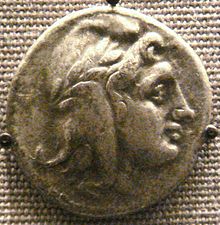| Amastris | |
|---|---|
| Ἄμαστρις | |
 Didrachm of Amastris. Amastris was the first woman to issue coins in her own name. British Museum. Didrachm of Amastris. Amastris was the first woman to issue coins in her own name. British Museum. | |
| Born | Persia |
| Died | c. 284 BC Heraclea Pontica (modern-day Karadeniz Ereğli, Zonguldak, Turkey) |
| Spouses | Craterus Dionysius Lysimachus |
| Children | Clearchus II and Oxyathres |
| Father | Oxyathres |
Amastris (Ancient Greek: Ἄμαστρις; c. 340/39- 284 BC) also called Amastrine, was a Persian princess, and Tyrant-ruler of the city of Heraclea from circa 300 to her death. She was the daughter of Oxyathres, the brother of the Persian King Darius III. She was the first woman in the Mediterranean publicly identified as the political, economic, and administrative royal authority.
Life
Little is known about Amastris' life before her first marriage. From her paternal namesake, it can be concluded that she did not have brothers. As a Persian royal woman, she would have been trained in managerial duty.
Amastris was given by Alexander the Great in marriage to Craterus. However, in 322 BC, she married Dionysius, tyrant of Heraclea Pontica, in Bithynia and Craterus married Phila, one of the daughters of Antipater. The instigator of this separation is unclear, with some sources claiming it was instigated by Craterus, while others argue the opposite. Through this marriage, Dionysus was able to greatly increase his wealth, expand his power, and improve the welfare and loyalty of his subjects. They had three children together: Amastris, born around 321/0, Clearchus, born 320/19, and Oxyathres, born 319/8.

After the death of Dionysius in 305, Amastris became guardian of their children and regent queen of Heraclea. Several notable individuals joined her administration, including Antigonus I Monophthalmus temporarily.
Amastris married Lysimachus in 302. Together they may have had a son, Alexander (son of Lysimachus), though Alexander's maternity is controversial. After the Battle of Ipsus, Lysimachus summoned Amastris to Sardis. Shortly after, they separated and Lysimachus married Arsinoe II, one of the daughters of Ptolemy I Soter, the first Pharaoh of Ptolemaic Egypt.
After her marriage to Lysimachus ended Amastris retired to Heraclea, which she governed as tyrant in her own right. She remained an ally of Lysimachus. She also founded a city named after herself, Amastris, shortly after 300 on the sea-coast of Paphlagonia through the fusion (synoecism) of four smaller towns: Sesamus, Cromna, Cytorus, and Tium. Tium later regained its autonomy, but the other three remained part of the city and Amastris' territory. She was involved in the city's resettlement and likely received religious honors as its founder and protector. Either through her rule, heritage, or one of her marriages she was considered basilissa, as is written on her coinage.
She was drowned by her two sons around 284 but the matricide was avenged by Lysimachus, who made himself master of Heraclea and put both Clearchus and Oxyathres to death.
References
- Arrian, Anabasis Alexandri, VII. 4.
- ^ Monica D'Agostini. (2020). Can Powerful Women Be Popular?: Amastris: Shaping a Persian Wife into a Famous Hellenistic Queen. In Celebrity, Fame, and Infamy in the Hellenistic World. Edid. Riemer Faber. Canada: University of Toronto Press.
- ^ van Oppen de Ruiter, Branko F. (2020). "Amastris: The First Hellenistic Queen". Historia (in German). 69 (1): 17. doi:10.25162/historia-2020-0002. ISSN 0018-2311. S2CID 213903613.
- Harders, Ann-Cathrin (2016). "Seleukos Nikator and His Wives". In Coskun, Altay; McAuley, Alex (eds.). Seleukid Royal Women. Historia - Einzelschriften 240. Franz Steiner Verlag. pp. 25–38. ISBN 9783515112956.
- ^ Chris Bennett, "Three Notes on Arsinoe"; in: A Delta Man in Yebu, edited by A. K. Eyma
- ^ Badian, Ernst (October 2006). "Amastris". Brill's New Pauly. doi:10.1163/1574-9347_bnp_e117300.
- ^ Diodorus Siculus, Bibliotheca, XX. 109
- ^ Bagnall, Roger S; Brodersen, Kai; Champion, Craige B; Erskine, Andrew; Huebner, Sabine R, eds. (2013-01-21). The Encyclopedia of Ancient History (1 ed.). Wiley. doi:10.1002/9781444338386.wbeah30433. ISBN 978-1-4051-7935-5.
- ^ Memnon, History of Heracleia, 4-6
Sources
- Henry Gardiner Adams, ed. (1857). "Amastris". A Cyclopaedia of Female Biography: 35. Wikidata Q115651705.
- Heckel, Waldemar (2006). Who's Who in the Age of Alexander the Great: Prosopography of Alexander's Empire. Blackwell Publishing. ISBN 978-1405188395.
External links
- Ulrich Wilcken: Amastris 7. In: Paulys Realencyclopädie der classischen Altertumswissenschaft (RE). Vol. I,2, Stuttgart 1894, szpalta 1750.